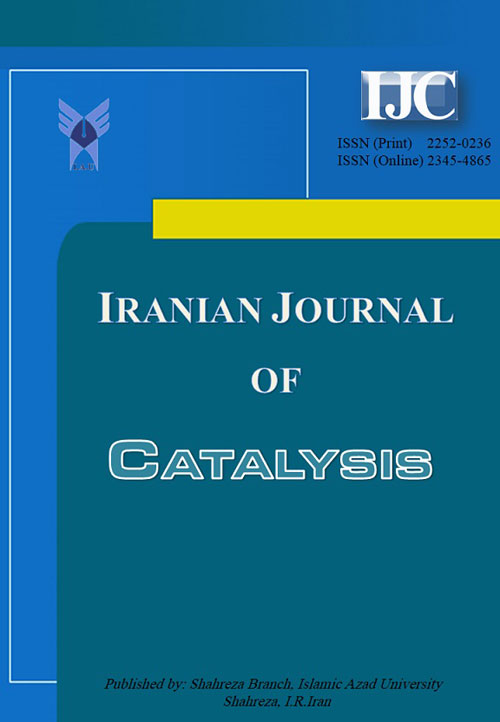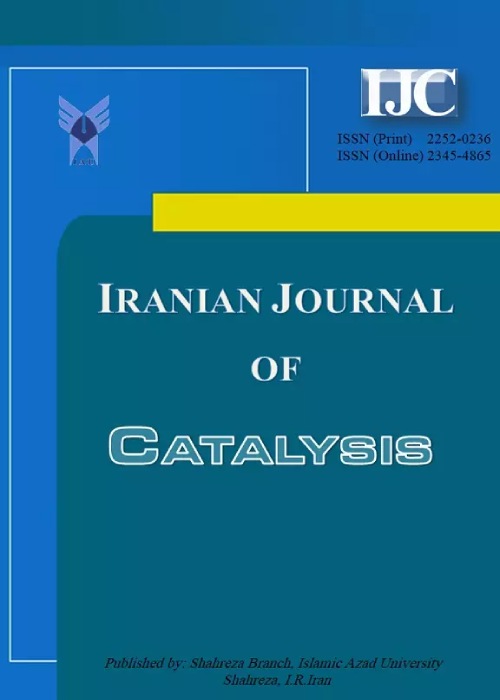فهرست مطالب

Iranian Journal of Catalysis
Volume:5 Issue: 2, Spring 2015
- تاریخ انتشار: 1394/01/28
- تعداد عناوین: 13
-
-
Pages 105-111(Diacetoxyiodo)benzene has been used as an efficient catalyst for an improved and rapid one-pot synthesis of biscoumarin derivatives in excellent yield under reflux condition using water as a environmentally benign reaction medium. This aqua mediated Knoevenagel condensation of various aromatic and hetero-aromatic aldehydes with 4-hydroxycoumarin using catalytic amount of (diacetoxyiodo)benzene devoid the route of expensive, corrosive reagents and toxic solvents. Along with the routine aldehydes, the aldehydes like aryl-sulphonyloxybenzaldehyde, aryl-carbonyloxybenzaldehyde also leads to the product under the reaction conditions. High yields, shorter reaction times, one pot condensation, operational simplicity, easy work-up, purification of products by non-chromatographic methods are some additional features of this method.Keywords: Biscoumarin, Hypervalent iodine, Aromatic aldehydes, Water, Condensation reaction
-
Pages 113-117The synthesis of diethyl/methyl 1,3-diaryl-1,2,3,6-tetrahydro-pyrimidine-4,5-dicarboxylates can be achieved using one-pot reaction from dialkylacetylene dicarboxylate, amines, and formaldehyde by employing hydrated phosphomolybdic acid (H3[P(Mo3O10)4].xH2O) as catalyst at room temperature. The effect of various solvent and catalyst amount was investigated. The salient features of the present method are: simple and straightforward work-up, cost-effective and environmentally benign procedure.The obtained yield of products was in the range of 75-92%.Based on the obtained results, the steric effects of the substituents in dialkylacetylene dicarboxylates played significant role in the rate of the reaction. When diethylacetylene dicarboxylate were used in this process, the corresponding product was obtained in good yields but in longer reaction time. Electron donating group on the amine was able to facilitate the transformation by giving evidently shorter reaction times.Keywords: Tetrahydropyrimidine, Dialkylacetylene dicarboxylate, H3[P(Mo3O10)4].xH2O
-
Pages 119-122In this study, an efficient and green process for the synthesis of dihydropyrimidin-2(1H)-ones from aromatic benzaldehydes, ethyl acetoacetate and urea using Al-MCM-41 as heterogeneous catalyst and microreactor under solvent-free conditions has been developed. The advantages of this method are easy work-up procedure, regeneration of the catalyst, clean and neutral reaction conditions.Keywords: Biginelli reaction, Al, MCM, 41, Dihydropyrimidinones, Heterogeneous catalyst
-
Pages 123-127A simple and mild one-pot three-component reaction for the preparation 1,4-dihydropyridines has been developed from various aldehyde substrates, 1,3-dicarbonyl compounds (dimedone) and ammonium acetate (Hantzsch method) in the presence of a catalytic amount of phospho sulfonic acid (PSA) as an efficient and heterogeneous solid acid in EtOH at room temperature. Preparation of PSA is straightforward and handling of the reagent is also easy. The attractive features of this protocol are: (i) The elimination of corrosive liquid acids; (ii) the use of an inexpensive and relatively non-toxic catalyst, and (iii) reusability of the catalyst.Keywords: PO(OSO3H)3, Hantzsch synthesis, Heterogeneous solid acid, Multi, component reactions, Aldehyde
-
Pages 129-134Kaolin-SO3H as a new solid acid is prepared via reaction of kaolin and chlorosulfonic acid. This natural based catalyst is very inexpensive and easy available. Imidazoles are an important class of heterocycles being the core fragment of different natural products and biological systems such as anti-allergic, anti-inflammatory, analgesic, antifungal, antimycotic, antibiotic, antiulcerative, antibacterial, antitumor and inhibitors of the p38 MAP kinase. A simple, highly versatile and efficient synthesis of 1,2,4,5-tetrasubstituted imidazoles is achieved using Kaolin-SO3H as a catalyst at moderate temperature under solvent free condition. The key advantages of this process are high yields with simple work-up using easy available inexpensive natural based catalyst.Keywords: 1, 2, 4, 5, Tetrasubstituted imidazoles, Kaolin, SO3H, Benzil, One, pot synthesis, Solvent, free condition
-
Pages 135-141Undoped and Mn-doped ZnO nanoparticles were successfully prepared by the hydrothermal method with different annealing temperature conditions. Structural, chemical and optical properties of the samples were studied by X-ray diffraction (XRD), Field Emission scanning electron microscopy (FESEM), UV-Vis spectrophotometry and Fourier transform infrared (FT-IR) spectroscopy. The phase purity was confirmed by X-ray powder diffraction (XRD) and XRD spectra showed that all the samples were hexagonal wurtzite structure and as the annealing temperature increases the material becomes less crystalline. In addition, the average crystal size was found to be 15-30 nm from SEM and XRD. It is seen that the optical band gap increases when the ZnO is doped with manganese and decreases when annealing temperature increases. The photoacatalytic activity of Undoped and Mn-doped ZnO nanoparticles was tested by the degradation of metyl orang (MO) under UV light and indicated that Mn-doped ZnO has higher photocatalytic activity relative to ZnO nanoparticles and photocatalytic activity decreases when annealing temperature increases.Keywords: Mn, doped ZnO, Photocatalyst, hydrothermal method, Annealing temperature
-
Pages 143-148Bis(indolyl)methanes are important group of bioactive metabolites of terrestrial and marine regions. They were synthesized by different methods. Herein, a clean, one-pot synthesis of bis(indolyl)methane derivatives by cyclo-condensation reaction of indole and various aldehydes using Sulfonic acid functionalized silica (SiO2-Pr-SO3H) in aqueous media is reported. The advantages of this new method were simple operation, good yields, short reaction times and easy work-up. Sulfonic acid functionalized silica as an efficient heterogeneous solid acid catalyst could be prepared by simple operation from commercially available cheap starting materials such as silica. It catalyzes various organic reactions and could be easily removed, recovered and reused without significant loss of activity.Keywords: Bis(indolyl)methane, SiO2, Pr, SO3H, Green synthesis, Multicomponent reaction (MCRs)
-
Pages 149-153The direct three component modified Mannich reaction via condensation of aldehydes, 2-naphthol or 2,7-naphthalendiol and piperidine to generate Betti bases has been carried out over L-proline (20 mol%) with high efficiency under solvent free conditions at 70 OC. Also, the reaction of aromatic aldehyde and 4-hydroxycoumarin in the presence of L-proline (20 mol%) in the ethanol under reflux conditions, lead to biscoumarin derivativesKeywords: Mannich type reaction, Betti base, L, proline, Biscoumarin, Multicomponent reaction
-
Pages 155-160Pyrazoles and isoxazoles are well-known important heterocyclic compounds that due to their participation in the structure of many drugs are very important. Pyrazoles and isoxzaloes can be prepared by oxidation of pyrazolines and isoxazolines respectively. In this work, trans-3,5-dihydroperoxy-3,5-dimethyl-1,2-dioxalane (DHPDMDO)/NH4I has been used as a new, powerful, nearly green, effective and inexpensive oxidant for oxidative aromatization of isoxazolines and 2-pyrazolines to corresponding isoxazoles and 2-pyrazoles in the presence of catalytic amount of acetic acid at room temperature in water/MeCN within short reaction time. All products obtained in high yields and good purity by aqueous work-up condition. More complex purification methods is not necessary in this methodology.Keywords: Trans, 3, 5, dihydroperoxy, 3, 5, dimethyl, 1, 2, dioxolane, Pyrazoles, Isoxazoles
-
Pages 161-167In the present study, the synthesis of diethylene triamine supported on cellulose biopolymer as a biodegradable solid basic heterogeneous catalyst was suggested. Then, the applicability of the synthesized catalyst cellulose bonded N-propyl diethylene triamine (CBPDETA) was tested for the synthesis of oxindole derivatives, an important class of potentially bioactive compounds. A various series of tetrahydrospiro-[chromene-indoline]-carbonitrile and dihydro-spiro[pyrano quinoline--indoline]-carbonitrile are obtained in water, an excellent solvent in terms of environmental impact, in high yield (78- 98%) from one-pot reaction procedure involving dicarbonyl/ 4-hydroxycoumarine, malononitrile and isatin compounds. The catalyst has been reused several times, without observable loss of activity and selectivity.Keywords: Heterogeneous catalyst, Cellulose, CBPDETA, Oxindole
-
Pages 169-174Na2SO4 as an inexpensive and effective catalyst has provided a green protocol for the synthesis of tetrahydrobenzo[b]pyran, pyrano[2,3-d]pyrimidinone and dihydropyrano[3,2c]chromene derivatives from the three-component domino reaction of aromatic aldehydes and malononitrile with 4-hydroxycoumarin/ dimedone/ barbituric acid in ethanol/water as a mixture of solvent that, this mixture entirely is green solvent. Products could simply be separated from the catalyst. Using neutral and mild conditions, short reaction time, environmentally benign procedure, high to excellent yields of the products and easy work-up without using column chromatography are the advantages of this method. By virtue of these advantages, sodium sulfate can be used as catalyst in the organic transformations.Keywords: Pyran annulated hetrocyclic systems, Na2SO4, Green protocol, Barbituric acid, 4, Hydroxycoumarin
-
Pages 175-182A new and efficient method has been developed for the synthesis of 4-aryl-7-benzylidene-1,3,4,5,6,7-hexahydro-2H-cyclopenta[d]pyrimidin-2-ones through Biginelli-like reaction of cyclopentanone, with urea/thiourea and aromatic aldehyde employing p-dodecylbenzenesulfonic acid (DBSA) as a recyclable catalyst under solvent-free condition. The recovered catalyst was recycled for further runs. The product formation takes place via a cross-aldol condensation of benzaldehyde with cyclopentanone in the presence of DBSA to produce benzylidene intermediate and subsequent Michael addition. The present approach offers the advantages of short reaction time, mild reaction conditions, high yields and convenient operation. All the products were obtained in good to excellent yields and the structures of the synthesized compounds were established by advanced spectroscopic data.Keywords: Biginelli reaction, p, Dodecylbenzenesulfonic acid, Cyclopenta[d]pyrimidin, 2, one, One, pot synthesis
-
Pages 183-185Meysam Yarie was born in 1987 in Malayer, Hamedan, Iran. He received his B.Sc. in Applied Chemistry (2010) from Malek-Ashtar University of Technology and M.Sc. in Organic Chemistry (2012) from Kurdistan University under the supervision of Dr. Kamal Amani. He is currently working towards his Ph.D. under the supervision of Professor Mohammad Ali Zolfigol. His research interest is catalysis, including the synthesis, characterization and applications of homogeneous and heterogeneous catalysis in organic synthesis.


